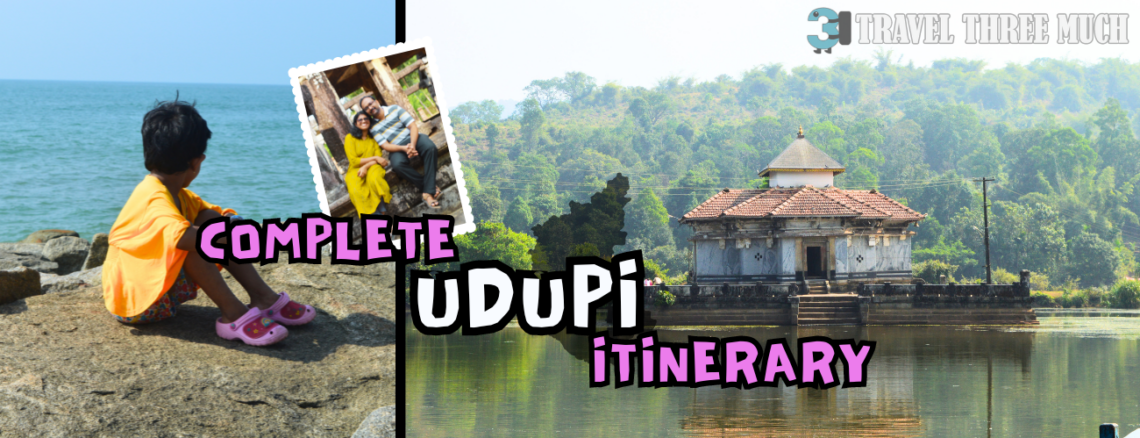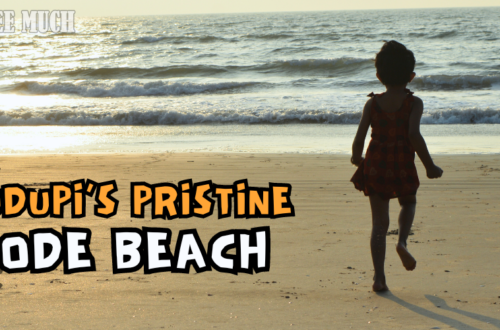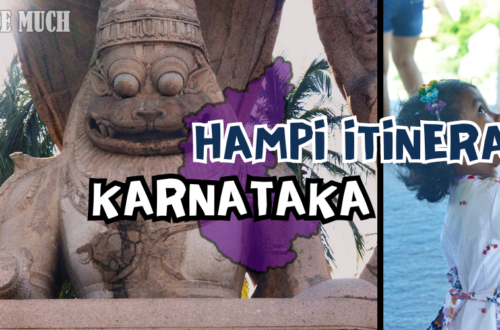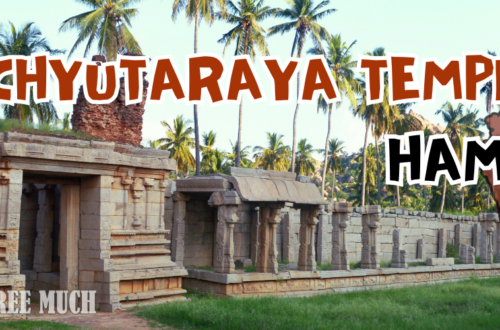
4-day Udupi Itinerary
Getting there
We reached Udupi on the day of Christmas in 2019, and needless to say, the town was beautifully decked up and looked festive, We had also pre-booked a Zoom car for the trip. The drive from Mangalore to Udupi was also quite nice and it reminded us a lot of Kerala and its coconut trees.

We’d planned our stay for the next 4 days at an AirBnb for its proximity to many of the places on the itinerary.
Udupi Itinerary – Day 1
Sri Krishna temple, Udupi
We made our way to the famous Udupi Sri Krishna Temple. The temple has a picturesque tank from where the line of devotees making their way to the inner sanctum started. We were able to reach the inner sanctum in about 45 minutes. There are free meals served throughout the day to the devotees that gather to seek the deity’s blessings.
Hoode beach
Since this place quickly made to our top favourite beaches of all time, I couldn’t refrain from writing more about this calm, beautiful beach.
Read about our experience at the beautiful Hoode beach here.

Udupi Itinerary – Day 2
Thimmana kudru Hanging Bridge
The suspension bridge connects the island of Thimmana Kudru to the mainland. We got to ride in a boat which a kind gentleman rowed us out on the Suvarna river. We got to see a jellyfish in the water as well.
We later learnt that the bridge was built by NCC cadets in 1991 as a part of their annual training with assistance from the families staying on the island. Truly an impressive feat, considering the bridge was built just by students!

Barkur Temples
We visited the ruined temples in what was once the capital of the Tulu kingdom, Barkur.
There was a sign that this temple complex was Kattale Basadi.
The complex had a Jain temple and a couple of other shrines – one dedicated to Shiva and the other to Vishnu. There was a stone Nandi outside the Shiva shrine and a Vishnu bas relief on the outer wall of the Vaishnavite shrine.


Maravanthe beach
After Barkur, we drove along the coast till Maravanthe beach. It was a scenic drive on the highway up to the beach. We saw some large crabs in the rock pools, barnacles that attached to the rocks that lined the shore and we had fun drawing shapes in the sand.
Malpe Beach and Sea Walk
We rounded off the day’s itinerary with a relaxed afternoon in the B&B followed by a trip to Malpe beach.
The beach was quite lively with adventure sports, boat rides, camel rides and the beachside market in full swing. We watched the setting sun light up the evening sky in ever changing hues.

Map of the day
Udupi Itinerary – Day 3
Varanga Jain Temple
The Varanga basadi or Jain temple is built in the middle of a lake. The temple is therefore accessible only by boat. The setting is very picturesque and doesn’t seem to get many visitors. The feeling as we slowly went by the row boat was pure bliss.
Just a few of us and the tranquility all around, simply beautiful! Till we were interrupted by some pre-wedding shoot team (obviously!!) But well, let’s focus on the good things here 🙂
There are large fish in the lake that one can see on the trip to the temple and back. If you’re lucky, you could also spot some turtles as they gracefully swim about in the waters surrounding the temple.

We were able to spend quite a bit of time at the temple before we returned back.
Anekere Lake and Kere basadi Adinath Swami
Kere Basadi Adinath Swami is another Jain temple that is set in a lake. But unlike the Varanga basadi, there is access all year round thanks to a footpath.
The setting however, is no less inspiring and the water lilies were in full bloom when we visited. The dash of bright pink juxtaposed amongst the blue of the sky reflected in the water interrupted by the purple and green leaves was a sight to behold.
The sanctum itself was closed when we visited due to an ongoing renovation but the exteriors were quite beautiful on their own.


Chaturmukha Basadi
The Chaturmukha basadi sits atop a hill. The Chaturmukha refers to the four symmetrical faces of the Jain temple (basadi is the term used for Jain temples). The basadi is built completely from carved granite blocks.
There was a power cut when we visited and so the sanctum was lit only from the lamps’ light. And that was indeed a blessing in disguise!
We were able to get a taste of what worship must’ve felt like in the 15th-16th centuries when the temple and the famous Gomateshwara statue it faces were consecrat
The outer corridors featured bas reliefs on each of the four faces of the base of the pillars that supported the roof and the pillars themselves were a mix of cylindrical and cuboidal structures with ornate carvings where the pillars met the ceiling.

Gomateshwara statue
After the Chaturmukha basadi, we made our way to the Gomateshwara statute, called the Karkala Gomateshwara. The statue sits atop a hill, shielded from view until the last few steps are climbed, making it an awe-inspiring sight.
This statue is from the 15th century and is said to be inspired by the statue at Shravanabelagola.
The temple had a pillar at the entrance with a Yaksha in a niche. The inner sanctum had a corridor on 3 sides with more Tirtankara images.

St. Lawrence Basilica
The St.Lawrence Basilica was built in the years between 1839 and 1900, with its origins in the legend of a foot-tall wooden statue of St.Lawrence that became immovable at the site of the present-day church when pilgrims in search of a site to build a church, set down the statue to have a drink at a spring nearby.
When we visited the church, it was just after some celebrations and we saw a nativity scene on display within the church grounds.
It was close to midday and we seemed to be the only ones at the church. It was a beautiful and serene setting for our midday break.

Map of the day
Udupi Itinerary – Day 4
St. Mary’s island
The journey to St. Mary’s Islands began at Malpe beach. There are ferries that leave every 20 minutes or so from Malpe to the islands. But the ferry service depends on the presence of tourists on a given day and we had originally planned to visit St. Mary’s Islands on Day 3 but the ferries didn’t ply as there weren’t enough passengers.
The ferry launches from the jetty near the Malpe Sea Walk. We saw the Malpe lighthouse and the island with the Daria Bahadurgad fort from afar as our ferry made its way towards the St. Mary’s Islands’ Coconut Island.
There were plaques and displays that explained the significance of the islands – from geological and historical perspectives. The islands are the only columnar lava deposits in India and are recognized as a National Geological Monument.
The islands are also the site of Vasco Da Gama’s arrival from Portugal, who named the islands in dedication to St. Mary, the mother of Christ, before he made his way to Calicut.
The island had a few setups that sold snacks and tender coconut stalls. There were a couple of artificial structures that seem to have been made only for scenic photographs. So, it’s a shutterbug’s paradise both from the natural splendor on display and the structures created on the island to promote tourism.

Mattu Beach
Once we were back from St. Mary’s island, we decided to drive to Mattu beach. The route we took was over the Malpe bridge (Padukere Main bridge)
It was a scenic drive down to Mattu beach with the sea on one side and the backwaters of the Udayavara river on the other side. We saw many plovers on the beach and Mattu beach had very few people on it. After spending some time on the beach, we drove back to our stay and made our way back to Mangalore for our flight back home.

Map of the day
And with that, our pleasant and enriching Udupi vacation came to an end. Back to Chennai!




